Belonging to the family Ursidae, bears are mammals that are widely distributed all over the world with the exception of Antarctica and Australia.
These mammals are known for their exceptional sense of smell, big, sharp claws, and short tails. Their size ranges from four feet to eight feet long. On average, bears have a lifespan of 25 years in the wild, and 50 years in captivity.
Currently, there are eight species of black bears that exist in this world. For this post, we rank them down from smallest to biggest.
Table of Contents
1. Sun Bear (Ursus malayanus)

The smallest of all bear species, sun bears can be found in lowland forests of Southeast Asia, particularly in the countries of Brunei, Cambodia, China, India, Indonesia, Laos, Malaysia, Myanmar, Thailand, and Vietnam.
Like the sloth bear, sun bears are mostly insectivorous. They earned their nickname ‘honey bears’ for their love of bees and their beehives.
Their ability to be amazing climbers allows them to forage on trees at night, feeding on insects, as well as rodents, lizards, small birds, berries, roots, and fruits.
These bears have long claws which they use to dig on trees and search for prey. Their insanely long tongue also allows them to extract honey from beehives.
Being the smallest of all bear species, sun bears can only grow about half the size of an average North American Black Bear.
Male sun bears weigh up to 150 pounds (68.03 kg), while females are slightly lighter at 100 pounds (50 kg). These bears’ small stature enables them to sleep on high platforms, usually on the branches of trees.
In the wild, sun bears have a life expectancy of up to 25 years.
2. North American Black Bear (Ursus Americanus)
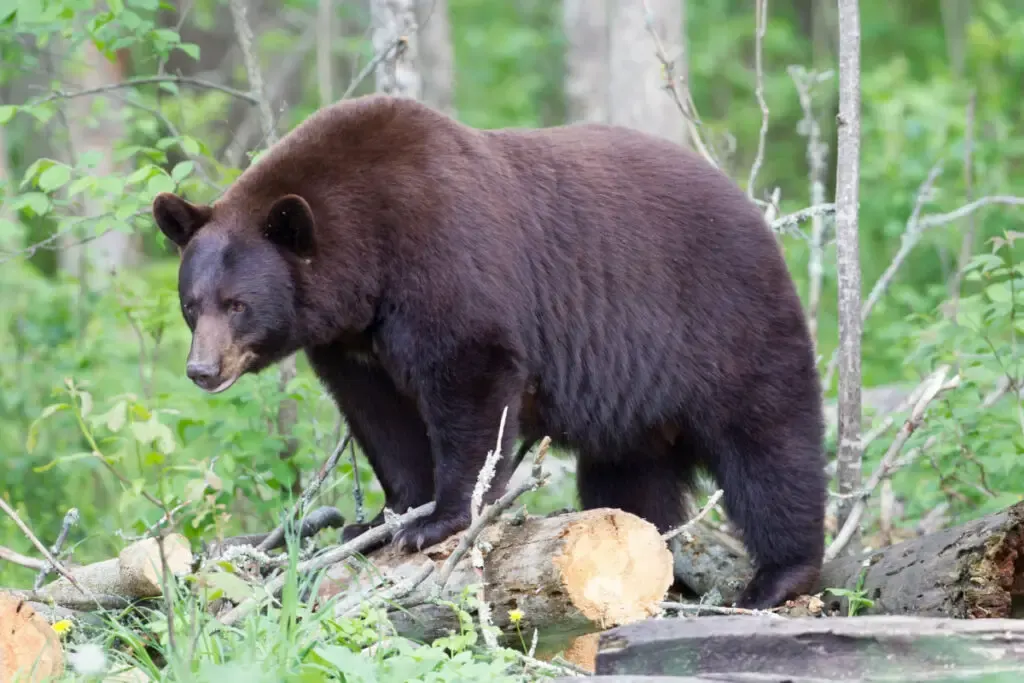
The North American Black Bear is the most commonly found bear in North America.
An omnivorous mammal, these bears’ diet consists of about 85% vegetables, grasses, roots, fruits, and berries. They also love to eat fish, carrion, insects, and other small vertebrates, but they’re not keen hunters.
However, these bears are excellent swimmers and climbers. They are frequently found playing with the water in rivers, or climbing trees in the mountains.
The North American Black Bear is a medium-sized bear. Males weigh from 130 to 660 pounds (60 to 300 kg), while females are lighter at 90 to 175 pounds (40 to 80 kg). Both genders’ height can vary from 50 to 75 inches (130 to 190 cm).
In the wild, black bears can live for 20 to 25 years. Although there are some black bears who exceed this average lifespan, most of them are not able to reach old age because they are hunted by humans.
North American Black Bears are not dangerous to humans. They might release a loud yell, which can sound intimidating. However, they are most likely to run away when surprised, or terrified.
Another pleasant quality of black bears is they like to get drunk. They are also skillful mammals who know how to open twist-off jars and drink beers.
Depending on their subspecies, black bears may come in various colors, including white and cream for Spirit bear, and they may also be blue-gray, brown, cinnamon, or blue-black.
3. Andean Bear (Tremarctos ornatus)
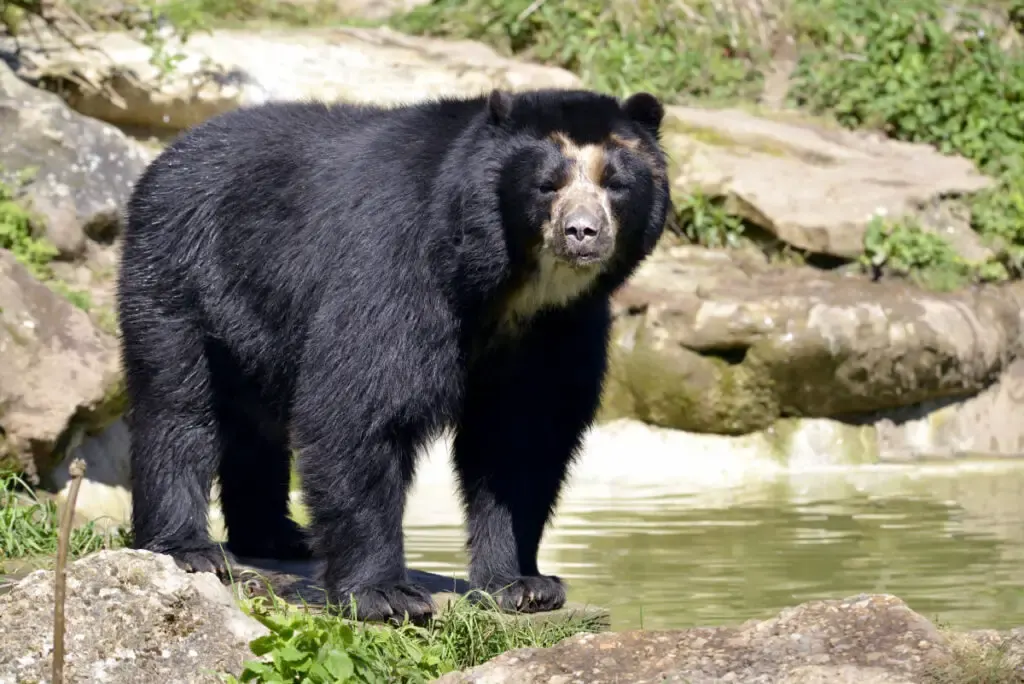
Also referred to as the ‘Spectacled Bear’, the Andean bear is native, and can only be seen in the Andes Mountain region in South America, particularly in the countries of Argentina, Bolivia, Colombia, Ecuador, Peru, and Venezuela.
Due to habitat loss which leads to their decrease in population, these bears are considered endangered species. Hunting for trophy and religious belief, and pet trade also contributes to their intensive decrease in population.
They are the last existing short-faced bear, and they belong to the vulnerable group which is why it is illegal to hunt and kill them.
Andean Bears are the largest carnivores in their region. Despite this, these bears only eat 5% of meat in their total diet.
A medium-sized bear, male Andean bears are usually three times larger than females, weighing around 220 to 440 pounds (100 – 200 kg), while females are lighter at 77 to 181 pounds (35 to 82 kg). Both genders’ length ranges from 47 to 79 inches (120 – 200 cm).
Andean bears come in different colors, including almost black, jet black, dark brown, and reddish shade. A beige-colored marking is also found along their face and upper chest. Compared to other bear species, Andean bears have rounder faces and short snouts.
The Andean bear’s lifespan in the wild is unknown. In captivity, they can live for around 20 years or more.
4. Sloth bear (Melursus ursinus)
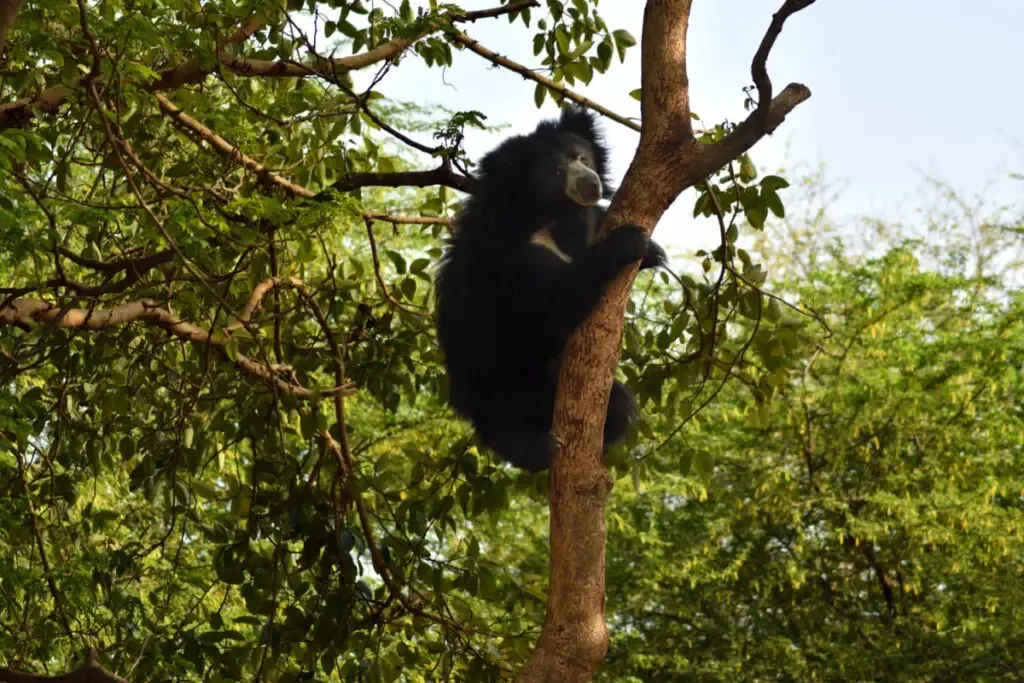
Sloth bears are found in Bhutan, India, Nepal, Bangladesh, and Sri Lanka. They have stocky bodies, with long, shaggy, black fur. Along with this, they have a distinct U-, V- or Y-shaped marking on their chest.
Sloth bears are nocturnal and insectivorous bears. Their long, curved, hook-like claws allow them to climb trees and search for termites and ants. At night, they can be heard releasing loud grunts and snorts.
Even from a long-distance, they can be heard digging up termites from trees. Aside from foraging insects, they also feed on honeycomb, and a few kinds of fruits, including wood apple, fig, ebony, jackfruit, and mangoes.
Interestingly, these bears are sometimes kept as pets by the British military. In India, where they are native, sloth bears are also trained to be ‘dancing bears’. However, in the wild, these bears are very aggressive, and have the tendency to attack humans even when they’re not provoked.
In terms of size, male sloth bears can weigh up to 310 pounds (140.61 kg), while females are lighter at 210 pounds (95.25 kg). Both male and female sloth bears grow to about 6 feet (182.88 cm) in length.
In the wild, sloth bears can live for up to 20 years. While in captivity, they can live for up to 40 years.
5. Panda Bear (Ailuropoda melanoleuca)
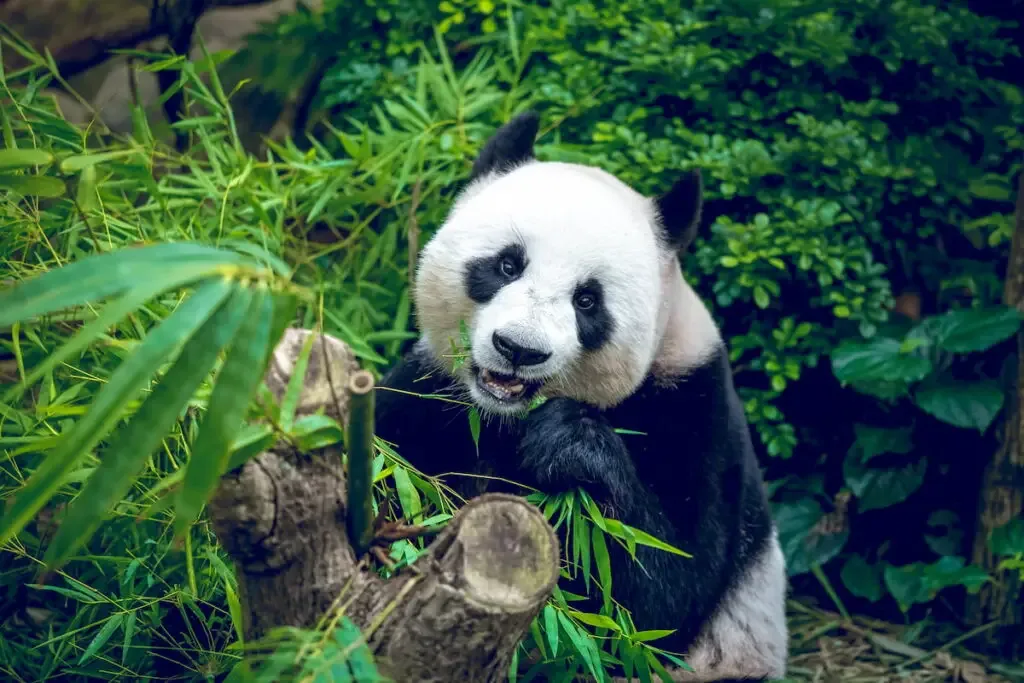
Also known as the ‘Giant Panda’, or simple panda, panda bears are found in bamboo forests, rainy mountains of southwestern China. These bears are also native to South Central China.
Pandas are considered one of the world’s rarest and most endangered mammals. For this reason, pandas are a popular symbol for conservation movements. Only about 1,500 to 2,000 pandas are known to survive in the wild.
Like all bear species, the giant panda’s digestive system is designed to eat both vegetables and meat. However, panda almost only eat bamboo. Considered as a grass, bamboos have low nutritional content.
This adds to the frustration of saving pandas, along with their low interest to reproduce. Since they don’t get enough energy with their diet, pandas tend to move very little. They don’t like hills or social interaction. Most of the time, they just sit or sleep.
Pandas are known for their black-and-white fur. They are medium-sized bears with males having an average weight of 350 pounds (160 kg), while females are lighter than males at 150 to 276 pounds (70 to 125 kg).
In the wild, giant pandas can live for up to 20 years, while in captivity, they are known to live for up to 30 years.
6. Asiatic Black Bear (Ursus thibetanus)
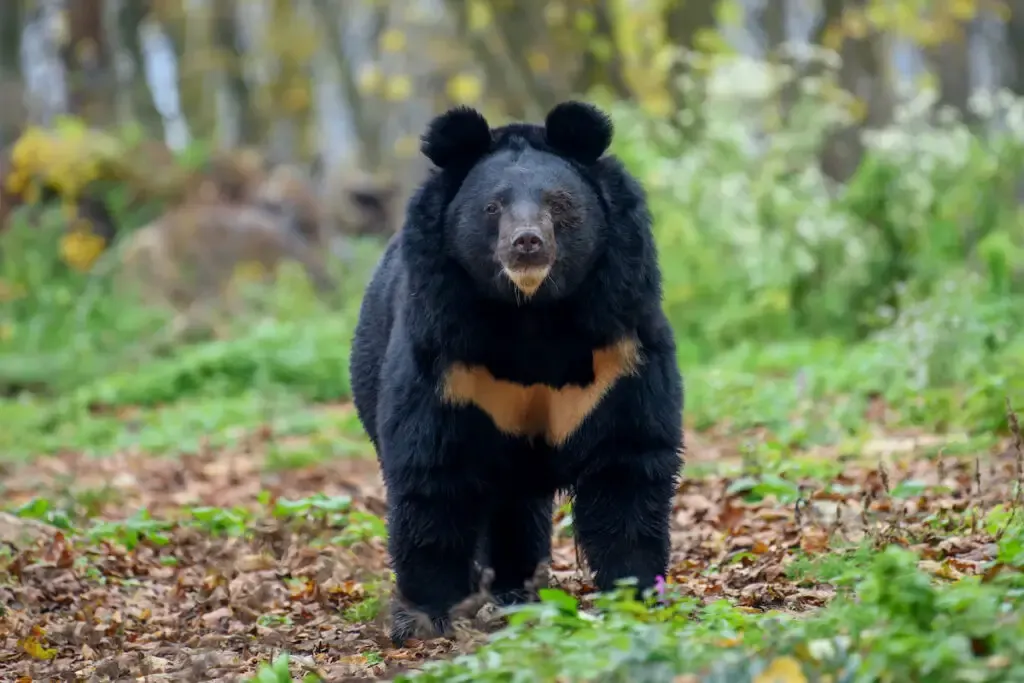
Also called Moon Bear or Himalayan Black Bear, Asiatic Black Bears are found in countries located in eastern Asia, including Afghanistan, China, Bangladesh, Cambodia, India, Bhutan, Japan, Iran, North Korea, Laos, Malaysia, Nepal, Myanmar, Mongolia, Russia, Pakistan, Vietnam, and Taiwan.
These bears have long, black fur and a unique white patch on the chest. They have large ears, and their hair around the shoulders and throat tend to be longer.
Asiatic Black Bears are omnivores, although they consume more vegetable matter than meat, including grasses, fruits, vegetables, berries, seeds, and honey. They also eat small mammals, birds, mollusks, carcasses, fish, and seafood. In fall, these bears will also feed on insects, bugs, and nuts.
Asiatic Black Bears are medium-sized bears with an average height of 4.5 to 5.4 feet (137.16 to 164.59 cm), and a weight of 198 to 254 pounds (89.81 to 115.21 kg). Males are usually bigger and heavier than females, reaching up to 400 pounds (181.43 kg).
These bears have an average life span of 25 to 30 years in the wild, while they can live up to 35 years in captivity.
7. Brown Bear (Ursus Arctos)

Brown Bears are commonly found in Alaska, western Canada, and some areas of Washington, Wyoming, and Montana. Small populations of this species can also be found in some parts of Asia and Europe.
Brown bears are omnivores who eat almost anything that they encounter, as long as it is edible.
Therefore, their diet will vary depending on the availability of food. Fortunately, these bears have jaw structures that are capable of chewing different kinds of food.
In general, 90% of a brown bear’s diet consists of vegetation, including fruits, vegetables, berries, flowers, grasses, roots, bulbs, and even fungi, such as mushrooms.
Meanwhile, those brown bears who live in coastal regions may eat clams, crab, and other seafood.
During summer and fall, they will also eat bugs, insects, and other animal matters, including beehives. They will also forage birds, and other mammals, such as rodents, mice, marmots, squirrels, and rats.
Like black bears, brown bears also come in various colors, including black, different shades of brown, and blonde.
Depending on the subspecies, on the geographic location, and on the availability of food, a brown bear’s size may vary greatly from very large size to smaller sizes. On average, male brown bears weigh 478 pounds (217 kg), while females weigh 335 pounds (152 kg.)
The “Big Browns,” or the largest variety of this bear species is found along the coast of Alaska and in Russia. The big bears, which reach up to 1,500 pounds (700 kg), are now scarce.
Some subspecies of brown bears include Himalayan Red Bear – a bear with a cinnamon-colored coat, Grizzly Bear – an endangered North American subspecies of brown bear, and Kodiak Bear – the largest subspecies of brown bears.
In the wild, brown bears have an average life span of 25 to 30 years.
8. Polar Bear (Ursus Maritimus)
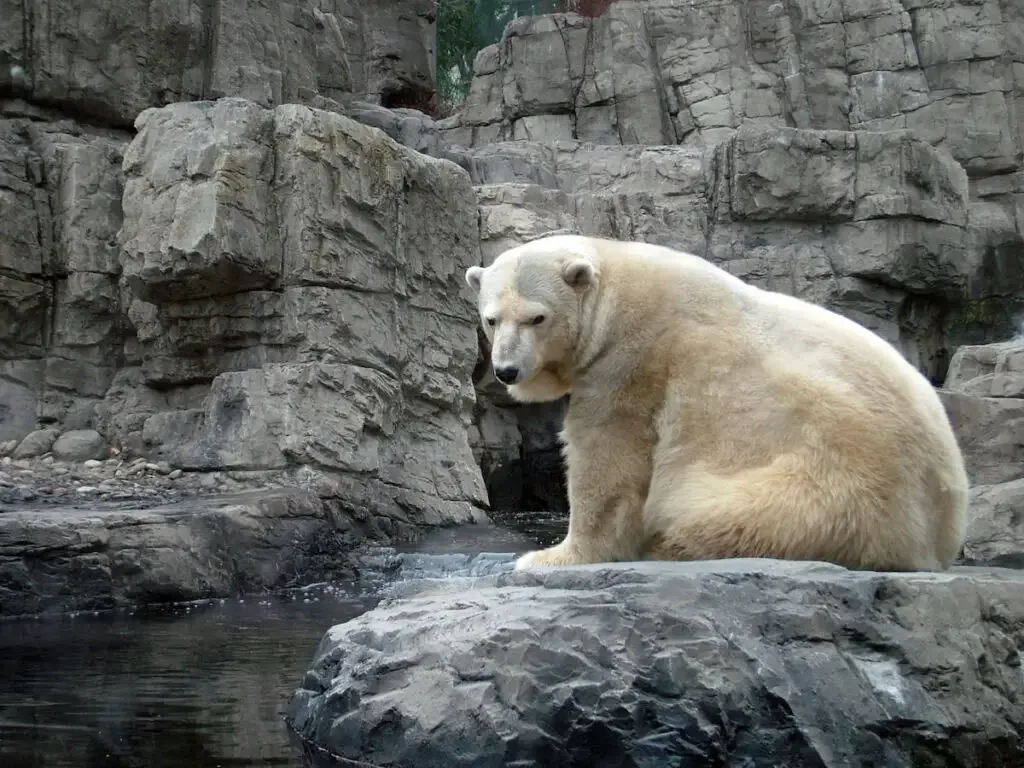
The largest bear in the world, Polar Bears are found in the Arctic, but not in Antarctica.
They are excellent swimmers, and spend most of their time in the region’s coastal waters. Their big front paws and slightly-webbed feet allow them to swim flawlessly.
Living in one of the world’s coldest regions, polar bears protect themselves from the extreme weather through their thick, insulated coats.
Their hair extends to the bottom of their paws which keeps their feet protected from the cold surface of ice sheets. Beneath the polar bear’s white coat is black skin.
On average, female polar bears reach a height of 6 to 8 feet (182.88 to 243.84 cm), and a weight of 330 to 650 pounds (149.68 to 294.83 kg). On the other hand, male polar bears reach an average height of 8 to 10 feet (243.84 to 304.8 cm), with weight ranging from 550 to 1,700 pounds (249.47 to 771.10 kg). Usually, male polar bears are two to three times larger than females.
Polar bears typically forage seals by lunging on them from ice sheets. Polar bears have an outstanding sense of smell that they can even smell a seal that is one mile away. If there’s an opportunity, these bears will also devour carcasses.
Like brown bears, polar bears can live from 25 to 30 years in the wild.
Final Words
According to the International Union for Conservation of Nature (IUCN), six of the eight species of bears are considered vulnerable, or endangered, with the exception of black and brown bears.
Some of the reasons for this are habitat loss, development of cities and farms, trophy hunting, logging, pollution, and climate change.
Source/s:
- https://bearwithus.org/8-bears-of-the-world/
- https://www.popsci.com/science/gallery/2013-06/bear-species-order-quality/
- https://www.nationalgeographic.com/animals/mammals/facts/bears-grizzly-polar-panda
- https://www.worldatlas.com/articles/how-many-types-of-bears-are-there.html
- https://www.nationalgeographic.com/animals/mammals/facts/grizzly-bear
- https://www.nationalgeographic.com/animals/mammals/facts/sun-bear
- https://www.nationalgeographic.com/animals/mammals/facts/sloth-bear
- https://www.nationalgeographic.com/animals/mammals/facts/polar-bear
- https://www.bearbiology.org/bear-species/american-black-bear/
- https://en.wikipedia.org/wiki/Brown_bear#Dietary_habits
- https://www.pbs.org/wnet/nature/blog/polar-bear-fact-sheet/
- https://www.animallaw.info/article/biological-information-asiatic-black-bear
- http://www.bearsoftheworld.net/sloth_bears.asp
- https://en.wikipedia.org/wiki/Giant_panda#Description
- https://animals.mom.com/list-endangered-bears-3461.html
